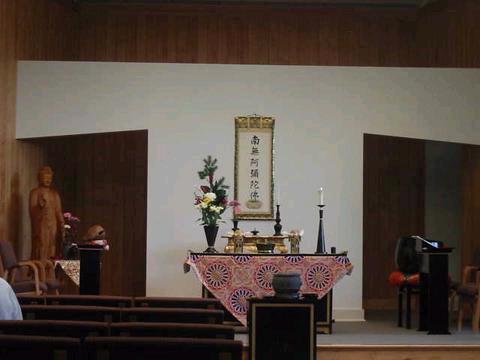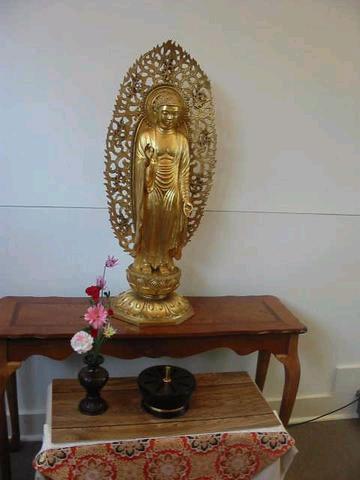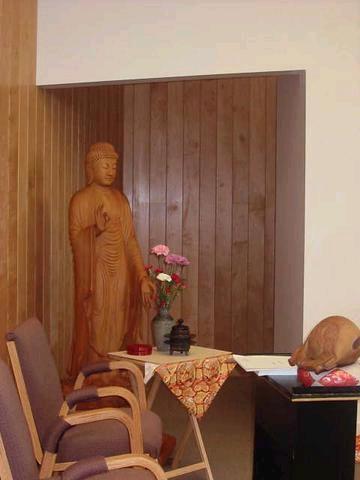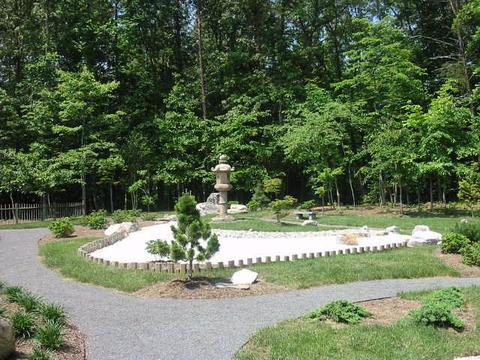|
 I visited the Ekoji Buddhist Temple in Fairfax Station, VA on an evening where they held a weekly meditation group. This Jodo Shinshu temple is part of the 105-year-old group of the Buddhist Churches of America. I was very apprehensive when I stepped into the foyer, not wanting to do something to offend anyone. I know that in my own church, visitors are welcome anytime and I am happy to say that I was immediately greeted with enthusiasm. Out of respect, I was asked to remove my shoes and either wear just my socks or borrow a pair of slippers. While I waited for another person to give me a tour, the girl that greeted me told me about the ojuzu (prayer) beads she held. She said that they were hand made in three lengths, 108 beads, 54 beads or 27 beads. A complete set usually has 108 beads representing the 108 human passions for people or for the 108 Brahmans. The main beads represent the Three Treasures of Buddha, Dharma and Sangha while the other beads represent Buddha’s teachings to overcome each suffering of beings. The strand of beads are held over both hands with the palms put together in gassho. This arrangement of the hands represents the oneness of Buddha, all beings, and the expression of reverence and gratitude. She also mentioned that when entering and leaving the main hall or Hondo, one must do it with gassho facing the shrine. I visited the Ekoji Buddhist Temple in Fairfax Station, VA on an evening where they held a weekly meditation group. This Jodo Shinshu temple is part of the 105-year-old group of the Buddhist Churches of America. I was very apprehensive when I stepped into the foyer, not wanting to do something to offend anyone. I know that in my own church, visitors are welcome anytime and I am happy to say that I was immediately greeted with enthusiasm. Out of respect, I was asked to remove my shoes and either wear just my socks or borrow a pair of slippers. While I waited for another person to give me a tour, the girl that greeted me told me about the ojuzu (prayer) beads she held. She said that they were hand made in three lengths, 108 beads, 54 beads or 27 beads. A complete set usually has 108 beads representing the 108 human passions for people or for the 108 Brahmans. The main beads represent the Three Treasures of Buddha, Dharma and Sangha while the other beads represent Buddha’s teachings to overcome each suffering of beings. The strand of beads are held over both hands with the palms put together in gassho. This arrangement of the hands represents the oneness of Buddha, all beings, and the expression of reverence and gratitude. She also mentioned that when entering and leaving the main hall or Hondo, one must do it with gassho facing the shrine.
 Our tour guide, Mark was then ready for us to enter the Hondo. As we walked inside the room, I noticed that it was not unlike my own church. There were chairs for people to sit in, pictures on the wall of the founding minister, Reverend Kenryu T. Tsuji and his wife, and in the front, there was an altar like area. The Reverend passed away in February of this year and I was told that he was highly regarded by his following. This main area of worship had a wooden statue of Amida Buddha to the left with a table or altar in the middle and a pot with burning incense in it. Our tour guide, Mark was then ready for us to enter the Hondo. As we walked inside the room, I noticed that it was not unlike my own church. There were chairs for people to sit in, pictures on the wall of the founding minister, Reverend Kenryu T. Tsuji and his wife, and in the front, there was an altar like area. The Reverend passed away in February of this year and I was told that he was highly regarded by his following. This main area of worship had a wooden statue of Amida Buddha to the left with a table or altar in the middle and a pot with burning incense in it.
 Mark explained that the burning of incense was called Shoko and it was to prepare the follower to receive the Dharma. It also was to remind people of the law of impermanency of all things. I found the incense very soothing and could certainly understand why its use, to prepare the worshipper, since I could feel myself relaxing and listening attentively to the speaker. Ekoji shares the teachings of Shinran, a 12th century Japanese Buddha whose teachings were based on the Amida Buddha. Mark explained that the Amida Buddha was indeed a real man that lived many, many years ago and that his stories had been passed down from teacher to student. I then noticed a book and was told that it was the service book and that it was comprised of the words and the teachings of Buddha. To the right of the altar was a large bell that was used during the services to wake up the follower in preparation for the service. Mark explained that the burning of incense was called Shoko and it was to prepare the follower to receive the Dharma. It also was to remind people of the law of impermanency of all things. I found the incense very soothing and could certainly understand why its use, to prepare the worshipper, since I could feel myself relaxing and listening attentively to the speaker. Ekoji shares the teachings of Shinran, a 12th century Japanese Buddha whose teachings were based on the Amida Buddha. Mark explained that the Amida Buddha was indeed a real man that lived many, many years ago and that his stories had been passed down from teacher to student. I then noticed a book and was told that it was the service book and that it was comprised of the words and the teachings of Buddha. To the right of the altar was a large bell that was used during the services to wake up the follower in preparation for the service.
 Mark said that their faith in following Amida Buddha acknowledges that alone, they are incapable of true goodness. That only through the compassion of Amida Buddha and the “Other Power” can they attain true Enlightenment and be free of a life of impermanence. They recognize that this compassion is given completely without reservation and to all living beings. He explained a scroll with the inscription,stood for “Namo Amida
Butsu” and was a prayer, giving honor to Amida Buddha. Mark said that their faith in following Amida Buddha acknowledges that alone, they are incapable of true goodness. That only through the compassion of Amida Buddha and the “Other Power” can they attain true Enlightenment and be free of a life of impermanence. They recognize that this compassion is given completely without reservation and to all living beings. He explained a scroll with the inscription,stood for “Namo Amida
Butsu” and was a prayer, giving honor to Amida Buddha.
 Na Na
mo
A
mi
da
buds
As I left, I notice a flag that was the Buddhist Flag with the first five stripes in blue, yellow, red, white and a lighter shade of red that are “self colors”. The sixth color is a combination of the five colors symbolizing the unity and harmony of Buddhists.
Finally, as we were leaving, Mark pointed out their Garden of the Three Treasures that was dedicated in honor of the Buddha, Dharma and Sangha with the hope that “this garden provide a sense of peacefulness and compassion to all who enter.” Because our visit was in the evening, we were not able to appreciate the beauty of this garden. However, I was able to see a picture of it on the temple’s web site.


I very much enjoyed this visit to the Ekoji Buddhist Temple. I not only learned more about a new religion but I felt very accepted and challenged to give new thought to the acceptance of others that may not believe as I have grown up to believe. The overall experience was warm, friendly, and very encouraging to consider “what else” is there to learn.
Return to top
|
 I visited the Ekoji Buddhist Temple in Fairfax Station, VA on an evening where they held a weekly meditation group. This Jodo Shinshu temple is part of the 105-year-old group of the Buddhist Churches of America. I was very apprehensive when I stepped into the foyer, not wanting to do something to offend anyone. I know that in my own church, visitors are welcome anytime and I am happy to say that I was immediately greeted with enthusiasm. Out of respect, I was asked to remove my shoes and either wear just my socks or borrow a pair of slippers. While I waited for another person to give me a tour, the girl that greeted me told me about the ojuzu (prayer) beads she held. She said that they were hand made in three lengths, 108 beads, 54 beads or 27 beads. A complete set usually has 108 beads representing the 108 human passions for people or for the 108 Brahmans. The main beads represent the Three Treasures of Buddha, Dharma and Sangha while the other beads represent Buddha’s teachings to overcome each suffering of beings. The strand of beads are held over both hands with the palms put together in gassho. This arrangement of the hands represents the oneness of Buddha, all beings, and the expression of reverence and gratitude. She also mentioned that when entering and leaving the main hall or Hondo, one must do it with gassho facing the shrine.
I visited the Ekoji Buddhist Temple in Fairfax Station, VA on an evening where they held a weekly meditation group. This Jodo Shinshu temple is part of the 105-year-old group of the Buddhist Churches of America. I was very apprehensive when I stepped into the foyer, not wanting to do something to offend anyone. I know that in my own church, visitors are welcome anytime and I am happy to say that I was immediately greeted with enthusiasm. Out of respect, I was asked to remove my shoes and either wear just my socks or borrow a pair of slippers. While I waited for another person to give me a tour, the girl that greeted me told me about the ojuzu (prayer) beads she held. She said that they were hand made in three lengths, 108 beads, 54 beads or 27 beads. A complete set usually has 108 beads representing the 108 human passions for people or for the 108 Brahmans. The main beads represent the Three Treasures of Buddha, Dharma and Sangha while the other beads represent Buddha’s teachings to overcome each suffering of beings. The strand of beads are held over both hands with the palms put together in gassho. This arrangement of the hands represents the oneness of Buddha, all beings, and the expression of reverence and gratitude. She also mentioned that when entering and leaving the main hall or Hondo, one must do it with gassho facing the shrine.  Our tour guide, Mark was then ready for us to enter the Hondo. As we walked inside the room, I noticed that it was not unlike my own church. There were chairs for people to sit in, pictures on the wall of the founding minister, Reverend Kenryu T. Tsuji and his wife, and in the front, there was an altar like area. The Reverend passed away in February of this year and I was told that he was highly regarded by his following. This main area of worship had a wooden statue of Amida Buddha to the left with a table or altar in the middle and a pot with burning incense in it.
Our tour guide, Mark was then ready for us to enter the Hondo. As we walked inside the room, I noticed that it was not unlike my own church. There were chairs for people to sit in, pictures on the wall of the founding minister, Reverend Kenryu T. Tsuji and his wife, and in the front, there was an altar like area. The Reverend passed away in February of this year and I was told that he was highly regarded by his following. This main area of worship had a wooden statue of Amida Buddha to the left with a table or altar in the middle and a pot with burning incense in it.  Mark explained that the burning of incense was called Shoko and it was to prepare the follower to receive the Dharma. It also was to remind people of the law of impermanency of all things. I found the incense very soothing and could certainly understand why its use, to prepare the worshipper, since I could feel myself relaxing and listening attentively to the speaker. Ekoji shares the teachings of Shinran, a 12th century Japanese Buddha whose teachings were based on the Amida Buddha. Mark explained that the Amida Buddha was indeed a real man that lived many, many years ago and that his stories had been passed down from teacher to student. I then noticed a book and was told that it was the service book and that it was comprised of the words and the teachings of Buddha. To the right of the altar was a large bell that was used during the services to wake up the follower in preparation for the service.
Mark explained that the burning of incense was called Shoko and it was to prepare the follower to receive the Dharma. It also was to remind people of the law of impermanency of all things. I found the incense very soothing and could certainly understand why its use, to prepare the worshipper, since I could feel myself relaxing and listening attentively to the speaker. Ekoji shares the teachings of Shinran, a 12th century Japanese Buddha whose teachings were based on the Amida Buddha. Mark explained that the Amida Buddha was indeed a real man that lived many, many years ago and that his stories had been passed down from teacher to student. I then noticed a book and was told that it was the service book and that it was comprised of the words and the teachings of Buddha. To the right of the altar was a large bell that was used during the services to wake up the follower in preparation for the service.  Mark said that their faith in following Amida Buddha acknowledges that alone, they are incapable of true goodness. That only through the compassion of Amida Buddha and the “Other Power” can they attain true Enlightenment and be free of a life of impermanence. They recognize that this compassion is given completely without reservation and to all living beings. He explained a scroll with the inscription,stood for “Namo Amida
Butsu” and was a prayer, giving honor to Amida Buddha.
Mark said that their faith in following Amida Buddha acknowledges that alone, they are incapable of true goodness. That only through the compassion of Amida Buddha and the “Other Power” can they attain true Enlightenment and be free of a life of impermanence. They recognize that this compassion is given completely without reservation and to all living beings. He explained a scroll with the inscription,stood for “Namo Amida
Butsu” and was a prayer, giving honor to Amida Buddha. Na
Na
